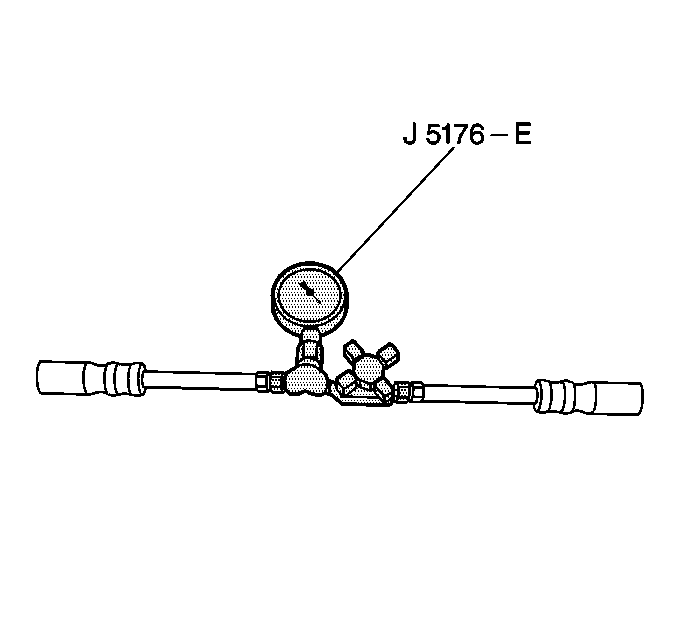
The power steering system
test is a method used in order to identify and isolate hydraulic circuit
difficulties. Prior to performing this test, make the following inspections
and the necessary corrections.
- Inspect the pump reservoir for the proper fluid level. Refer to
Checking and Adding Power Steering Fluid
.
- Inspect the pump belt for proper tension. Refer to the appropriate
procedure from the following list:
- Inspect the pump drive pulley condition. Refer to the appropriate
procedure from the following list:
- Perform the Diagnostic System Check. Refer to
Variable Effort Steering System Check
in Variable Effort Steering.
Important: Perform all the tests with the engine idling at the normal operating
temperature.
- Perform the following procedure:
| 5.1. | Place a container under the steering gear or the pump in order
to catch the fluid when disconnecting or connecting the hoses. |
| 5.2. | With the ignition OFF, disconnect the pressure hose at the steering
gear or at the power steering pump. |
| 5.2.1. | Install the J 5176-E
to both hoses. |
| 5.2.2. | Position the gauge between the shutoff valve and the pump. |
| 5.2.3. | Open the shutoff valve. |
| 5.3. | Remove the filler cap from the pump reservoir and check the fluid
level. |
| 5.3.1. | Fill the pump reservoir with power steering fluid to the full
mark on the dipstick. |
| 5.3.2. | While momentarily holding the steering wheel against the stop,
start the engine and check the connections at the J 5176-E
for leaks. |
| | Important: In order to prevent scrubbing flat spots onto the tires, do not turn
the steering wheel more than five times without rolling the vehicle in order
to change the tire-to-floor contact area.
|
| 5.5. | Insert the J 5421-02
in the reservoir filler opening. |
Move the steering wheel from stop to stop several times until the thermometer
indicates the power steering fluid in the reservoir has reached a temperature
of 65°-77°C (150°-170°F).
| | Notice: Do not leave the valve fully closed for more than 5 seconds, or the
pump could be damaged internally.
|
| 5.6. | Start the engine and check the pump fluid level. |
| 5.6.1. | Add power steering fluid, if required. |
| 5.6.2. | When the engine is at normal operating temperature, the initial
pressure reading on the gauge, with the valve open, should be in the 550-860 kPa
(80-125 psi) range. |
| 5.6.3. | If this pressure is in excess of 1380 kPa (200 psi),
check the hoses for restrictions. |
| 5.6.4. | Check the poppet valve for proper assembly. |
| 5.7. | Fully close the gate valve three times. |
Record the highest pressures attained each time.
| • | If the pressures recorded are within 9,308-9,998 kPa
(1,350-1,450 psi) or, for the C3500HD 10,101-10,446 kPa
(1,465-1,515 psi) and the range of readings
are within 345 kPa (50 psi), the pump is functioning
within specifications. |
| • | If the pressures recorded are high, but do not repeat within 345 kPa
(50 psi), the flow controlling valve is sticking. |
| • | Remove any burrs using crocus cloth or a fine hone. |
| • | Flush the system if the system contains dirt. |
| • | If the system is exceptionally dirty, disassemble the pump and
the gear. |
| • | Clean, flush, and reassemble the system before further usage. |
| • | If the recorded pressures are constant but between 690 kPa
(100 psi) and 9,308 kPa (1,350 psi), replace the flow
control valve and recheck the system. |
| • | Replace the rotating group in the pump if the pressures remain
low. |
| 5.8. | If the pump pressures are within specifications, leave the valve
open and turn the steering wheel to both stops. |
| 5.9. | Record the highest pressures and compare with the maximum pump
pressure recorded. |
If this pressure cannot be reached in at least one side of the gear,
the gear is leaking internally.
Disassemble and repair the gear.
| 5.10. | Shut the engine OFF. |
| 5.11. | Remove the testing gauge. |
| 5.12. | Reconnect the pressure hose. |
| 5.13. | Check the fluid level. |
Make the necessary repairs.
| 5.14. | If the problem still exists, examine the steering and the front
suspension. |

